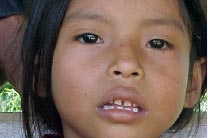You are here » Home » Telling Our Story
Case Study
Human rights initiatives help border communities overcome development challenges
A Border Peace Benefits Everyone

| |
Photo: USAID
|
|
This Aguaruna girl has benefited from gender and education initiatives to promote an enduring peace along Peru’s border with Ecuador.
When people know their rights, local authorities are more likely to be sensitive to their needs, and citizen participation in local governance and decision-making increases.
|
Challenge
The rural areas along Peru’s border with Ecuador are isolated and under-developed. Decades of border disputes have created a dangerous environment that few aid organizations have been able to confront. The area is rife with development challenges in gender, diversity, bilingual-intercultural relations, domestic violence and conflict resolution.
Initiative
When people know their rights, local authorities are more likely to be sensitive to their needs, and citizen participation in local governance and decision-making increases. After Peru and Ecuador signed their 1998 peace agreement, USAID began promoting an enduring peace by helping individuals and communities learn their rights and responsibilities and develop skills that will help them meet their basic needs. Educating and protecting the rights of women and indigenous people are especially important to the program.
Results
USAID has built upon the 1998 Peru-Ecuador peace agreement to improve the capacity of border communities to manage their own development. By integrating gender into all its activities, USAID also has increased respect for, and protection of, human rights, particularly those of indigenous people, women and girls. By 2004, 636 human rights promoters had been trained to increase citizens’ awareness of their rights and responsibilities and ability to establish mechanisms to protect them. A bilingual education program tailored to suit cultural needs has increased the number of girls attending school in the region, and initiatives to teach pottery and sports in 43 schools have successfully promoted gender equity and girls’ education. To ensure that these activities reap long-term benefits, USAID trained 1037 teachers on how gender, equity, diversity and intercultural relations affect schooling, benefiting more than 11,600 students.
Print-friendly version of this page (64kb - PDF)
Back to Top ^ | 

